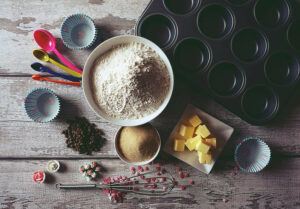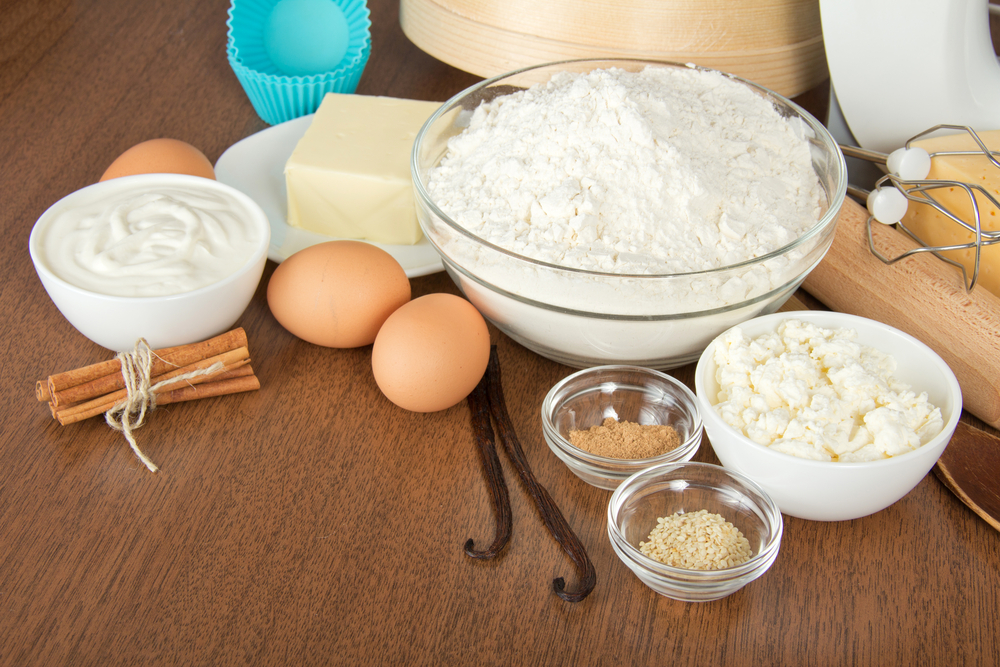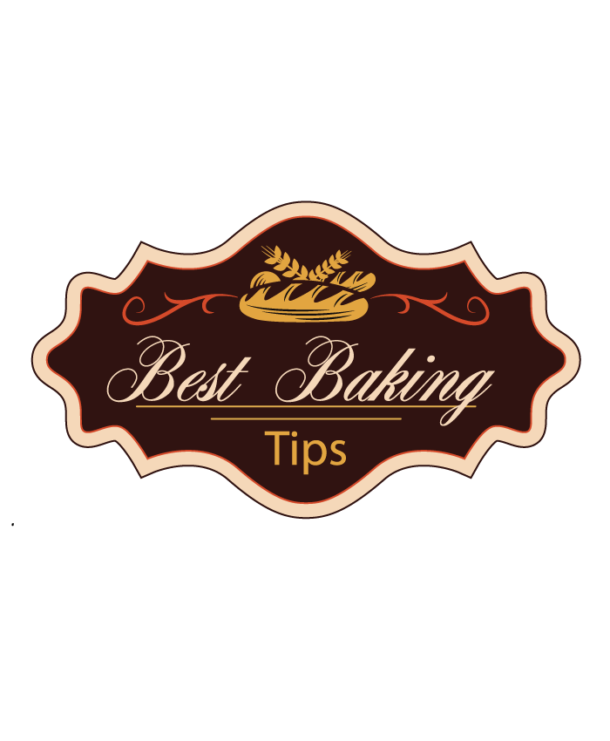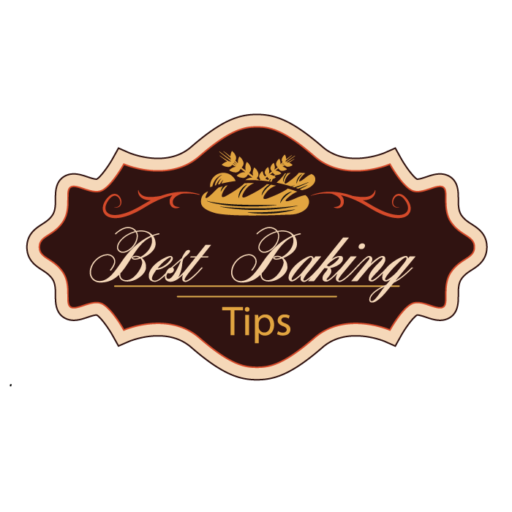==================
Affiliate Statement
Best Baking Tips is supported by our audience. When you purchase through one of our links, we may earn a small affiliate commission. As an Amazon Associate I earn from qualifying purchases. Your cost is not affected.
==================
Pantry Staples: The 7 Basic Baking Ingredients
 The 7 basic baking ingredients that every home should have may vary depending on preferences. However, including them in some form in your pantry enables you to quickly whip up pancakes, muffins, biscuits, or even a cake, without a special trip to the store.
The 7 basic baking ingredients that every home should have may vary depending on preferences. However, including them in some form in your pantry enables you to quickly whip up pancakes, muffins, biscuits, or even a cake, without a special trip to the store.
Of course, these are the basics. You need to keep the other ingredients on hand, according to the types of food you bake.
We’ll discuss:
- Flour
- Sweeteners
- Leavenings
- Salt
- Oils
- Milk (Dairy and plant-based)
- Eggs and plant-based substitutes
BONUS: Flavorings
1. Flour
We outlined the types of flours in our article: Baking with Whole Grain Flour.
While many of our recipes use all-purpose flour, we often suggest you try a whole grain version. In fact, few notice a flavor difference when using white-wheat flour in place of all-purpose.
While you need to keep some flour on hand, the various types might provide some storage concerns, especially if you keep a variety of flour types on hand. Flour is best kept in dry storage (see tips on storage here) but can be kept tightly sealed in the freezer for longer storage times.
Small households may find that 5# bags suffice for several weeks’ usage. However, a family that enjoys baked goods normally uses much more in a given month. Over time, you will find the right amount and the best types to keep in your home.
2. Sweetener
Most recipes call for plain granulated sugar. And it works fine in those foods. However, if you are planning to create some healthier options, you have choices.
Two healthier choices are allulose and stevia. Both are available in forms that can be substituted in equal amounts for granulated sugar.
We’ve created a detailed description of the sweetener choices here. In addition, we’ll note possible choices in the recipes as we go.
3. Leavenings: Baking Powder/Baking Soda/Yeast
Baking powder, baking soda, yeast… which one to use when? And can I substitute one for another?
Well, sometimes. Let me explain the differences.
Let’s begin with the baking powder vs baking soda controversy.
Baking Soda
Chemically known as sodium bicarbonate, produces carbon dioxide gas forming bubbles that create the lift or rise in baked goods. However, it needs a liquid and an acid (buttermilk, vinegar, or the like are often used) to do so. And that reaction begins as soon as they are combined so no time to waste once they are mixed!
Baking Powder
Consists of our gas-producing friend, baking soda, with the addition of an acid, usually, cream of tartar, mixed in. With a baking powder, all you need is a liquid or moisture to create those bubbles!
Most of the baking powder sold in stores is called “double-acting.” This simply means it has a two-part reaction. The first occurs immediately when the powder dissolves in the batter. However, the second occurs more slowly as it is heated. This two-part reaction allows for more flexibility. It allows you to let the batter or dough sit for a little while if needed before baking and still get the rise you’re after.
Mix Your Own Baking Powder by combining 2 parts cream of tartar to 1 part baking soda. So, for instance, if your recipe calls for 3 Tablespoons of Baking Powder, use 2 T cream of tartar and 1 T baking soda. However, you need to blend the two ingredients thoroughly, then use as directed. NOTE: However, this results in a single active compound. You will need to bake your product soon after mixing as there is no delay in the reaction.
Baking powder or baking soda helps create delicious baking powder biscuits, cookies, and cakes. Its action is quick and utilizes the carbon dioxide bubbles, as described.
Many baked goods such as bread, utilize yeast for the rising action.
Yeast

You probably have heard of yeast bread and cakes, but do you understand what yeast is and how it works? According to Wikipedia:
So how does this little microorganism make our bread rise so tall? Similar to the carbon dioxide bubbles of baking soda, yeast converts carbohydrates to carbon dioxide and alcohol. Known as fermentation, this creates lots of air bubbles that expand in warmth and even more during baking. During baking, the yeast dies and the air pockets become set. This leaves a soft, spongy texture on our yeast bread.
4. Salt
While we think of salt as a flavoring, and it is. But it does much more than that for our baked goods.
- Salt attracts or absorbs water, giving it the classification of a hygroscopic. When mixed into the dough that contains yeast, the salt absorbs some of the moisture from the yeast. This slows down the fermentation of the yeast. Without the added salt, the yeast might ferment too quickly, resulting in uneven baking results.
- It helps strengthen the gluten structure in the dough, which allows it to better hold carbon dioxide. This results in a much better rise when baking. And it prevents the dough from billowing up high, then deflating. Therefore, salt gives bread and pastries a better overall texture.
- Salt is a natural preservative. In baked goods, this is largely due, to the fact that salt is hygroscopic, which means it attracts moisture. This allows the salt to hold on to the moisture inside of your finished baked goods, ensuring they won’t go stale as fast as their non-salt-containing counterparts.
- It helps intensify and add richness to the colors of baked goods. Pastry chefs add a pinch of salt to their egg wash before brushing onto dough prior to baking. The result is a more beautiful, color-intensified crust
5. Oils
Most baking recipes call for some type of oil. Vegetable oil and butter might be the most used. However, consider other options such as olive oil, coconut oil, and even less known ones such as sesame oil.
Unless otherwise noted, oil substitutes in equal amounts. However, not all substitutes equal to the purpose.
Consider that coconut oil is solid at room temperature, but vegetable oil is liquid at the same temperature. Using dairy butter in a recipe that calls for vegetable oil will also change the texture of your final product.
Also, take into account the flavors. Some forms of olive oil and coconut oil bring a stronger flavor. Vegetable oil imparts a milder flavor than sesame oil.
6. Milk: Dairy or Plant-Based
The milk controversy continues.
Dairy Milk: for a recipe that calls for whole milk, skim milk may affect the texture or consistency. The reverse is also true, but the end result does not usually suffer. For cream ingredients, whole milk substitutes with a little effect texture. However, skim milk usually proves insufficient.
Non-Dairy Milk: These appear in our recipes more often in recent times, in part due to allergies to milk and also our increasing vegan population. When they do, you may use dairy milk in equal proportions.
Likewise, if a recipe calls for 1 cup of milk, most plant-based milk substitute equally. However, there are some slight differences in which plant milk. The main types we see today are rice milk, oat milk, soy milk, cashew milk, and almond milk. Others are becoming more prevalent, but let’s look at those types for now.
- Rice milk tends to be the thinnest consistency. It works well as a substitute for skim milk, but may need a boost to represent whole milk.
- On the other end of the spectrum, oat milk offers a creamy, full-bodied choice that easily replaces whole milk. In fact, we find it subs for cream in most cases, too.
- Just behind the oat milk, in our experience, is soy milk. We use this as a general replacement for any of the milk with great results each time. However, some people face soy allergies, so the other types of plant-based milk remain essential.
- Cashew, almond, and other nut milk are between the soy and rice spectrum. We use them primarily for skim milk replacements. However, they suffice in place of whole milk in many recipes.
All of those are generalities, however. Each region has unique brands that will vary from the others. If you plan to use plant-based milk, we suggest you experiment with the brands available near you.
7. Eggs
When we bake cakes, cookies, and even some bread, eggs make the list of ingredients for several reasons.
-
- Structure: Eggs bind with other ingredients to maintain the structure during and after baking.
- Leavening: Yes, eggs can be considered a leavening agent, as well as the other leavening products.
- Tenderizing: Eggs keep the baked product light and fluffy, creating a tender texture.
- Moisture: The proteins in both yolks and whites of the egg hold moisture in to retain the needed moisture. This ensures a tender product while helping to prevent mold development.
- Wash: Egg wash creates a protein-rich coating to repel excess moisture and give the bread loaf a beautiful shiny finish. Some baked goods containing seeds or nuts use an egg wash to hold the loose elements in place during baking.
- Emulsifier: You have probably heard that water and oil don’t mix. However, they do, with the addition of an emulsifier that breaks up the oil molecules into tiny particles that then suspend in water. Yolks contain lecithin while whites have albumin. Both of these work as emulsifiers to keep the oils and liquids blended. The result is a smooth batter.
- Flavor: Consider the difference in flavors between a silver-white cake and a yellow cake. The difference between the two is the inclusion of egg yolks in the yellowcake. Both are delicious in their own right. However, the flavors are strikingly different from one another.
Egg Substitutes for Basic Baking:
Food allergies, health issues, or plant-based living choices often create a need to substitute something for eggs in your baked goods. Your grocery sells items, often flax seed-based or baking powder-based, that replace eggs in recipes. However, creating substitutes at home is just as easy.
Our Primary Substitutes:
Use either of these to substitute for one large egg in your recipe. Increase each amount for added eggs. For instance, for two eggs, double each ingredient amount. Triple for three large eggs.
1- The Baking Powder-Oil Egg Replacer:
Mix 2 Teaspoons baking powder with 2 Tablespoons water and 1 teaspoon vegetable oil.
The resulting baked product will be nearly identical to that containing eggs. However, you will probably notice a slightly more crisp texture to the top and a slightly darker appearance.
2- Carbonated Water:
Use 1/4 cup carbonated water in place of each egg in your recipe.
Even simpler than our first option, carbonated water fills the need nicely! We doubt anyone can tell the difference when using carbonated water as compared to using whole eggs.
Other possible choices for replacing eggs in your recipes include:
Ground Flax Seed: 1 tablespoon ground flax seeds and 3 tablespoons of water = 1 large egg
Combine the flaxseed and water. Allow to thicken for at least 5 minutes before adding to your recipe. Flax egg creates a thicker batter than eggs do and often produces a slightly denser end product.
Chia seeds (whole or ground): 1 tablespoon chia seeds and 3 tablespoons of water = 1 large egg
Like with flaxseed, combine the chia seed and water, then let stand to thicken for about 5 minutes. Chia eggs create a light, tender end product but you will probably notice a slight crunch to the texture.
Arrowroot Powder: 2 tablespoons arrowroot powder and 3 tablespoons water = 1 large egg
Again, mix the powder and water before using in your recipe. Arrowroot creates a slightly more sweet end product but also a drier one. You might need to adjust your oil content slightly to accommodate the variation.
Applesauce or Mashed Bananas: 1/4 cup unsweetened of either = 1 large egg
Either of these produces a nice moist texture. However, you will notice the fruit flavor in your final product. Applesauce tends to add a bit more chewiness to baked goods while muffins make with bananas often have a slight gumminess.
While any of these will substitute, we have found our two primary ones (baking powder-oil, and carbonated water) perform much better in most cases. However, consider your own preferences, needs, and what you have available. And the choices for your baked goods. For instance, if you are making Apple Muffins, Applesauce might be the perfect substitute!
With these 7 Basic Baking Ingredients, your pantry is nearly ready for your next baking day!
However, before beginning any recipe, you need to read through all the ingredients like the basic baking ingredients to ensure that you have sufficient quantities to complete your project. Most of us have failed to do this at some point. It provides a lesson, for sure.
BONUS:
Flavorings, while not in every recipe flavorings are critical to many products we bake.
Many cookie and pastry recipes call for flavors such as vanilla, almond, or peppermint. When possible, we recommend using the real version, rather than artificial.
Other flavorings include spices such as cinnamon, nutmeg, and cloves.
However, other flavorings might include chocolate. A chocolate cake, for instance, uses cocoa or chocolate.
While it is possible to substitute flavorings, it may drastically change the resulting product. Before you decide to substitute chocolate for cinnamon in your Snickerdoodle cookie recipe, try finding a recipe that incorporates chocolate in the recipe. In fact, while some flavorings can substitute equally, many do not.
Read More





